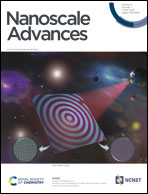Efficient charge transfer from organometal lead halide perovskite nanocrystals to free base meso-tetraphenylporphyrins†
Abstract
The efficient charge transfer from methylammonium lead halide, MAPbX3 (X = Br, I), perovskite nanocrystals (PNCs) to 5,10,15,20-tetraphenylporphyrin (TPP) molecules has been investigated in detail. The hydrophobically-capped MAPbX3 PNCs exhibited bright fluorescence in the solution state. However, in the presence of TPP, the fluorescence intensity was quenched, which is ascribed to the electron transfer from the PNCs to TPP. Photoluminescence (PL) spectroscopy and absolute quantum yield measurements were used to evaluate the fluorescence quenching. This efficient fluorescence quenching leads to an increase in the quenching efficiency value. The quenching of fluorescence intensity is not attributed to the change in lifetime, as evidenced by time-correlated single-photon counting (TCSPC) measurements, suggesting a static electron transfer from the PNCs to TPP molecules. Such a static fluorescence quenching corresponds to the adsorption of TPP onto the surface of hydrophobic PNCs, and has been examined via transmission electron microscopy (TEM). Cyclic voltammetry (CV) studies were used to compare the PNCs and PNCs@TPP nanocomposites, revealing that the electron transfer process takes place from the PNCs to the organic acceptor TPP molecules.



 Please wait while we load your content...
Please wait while we load your content...